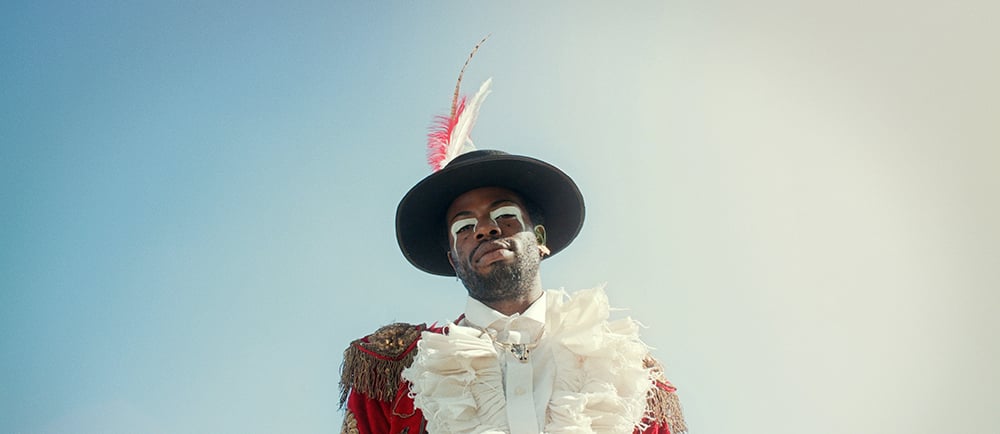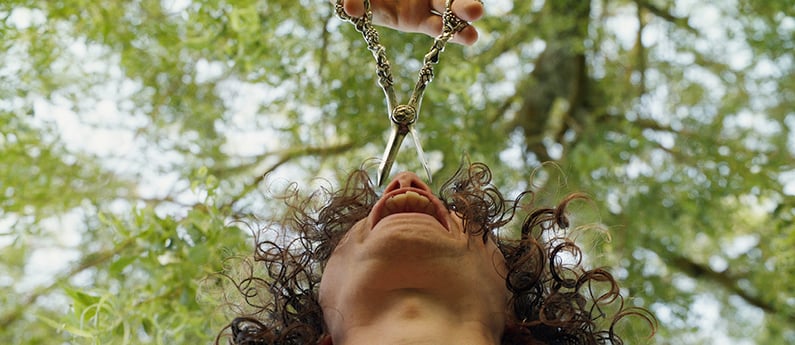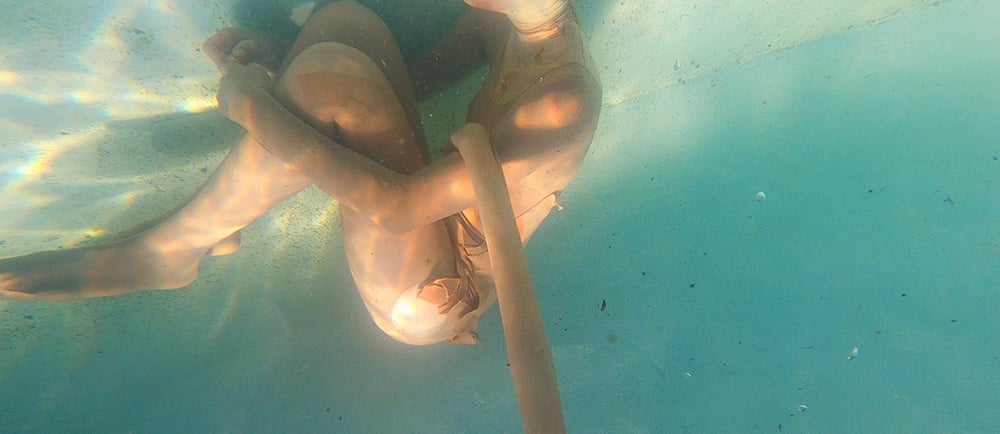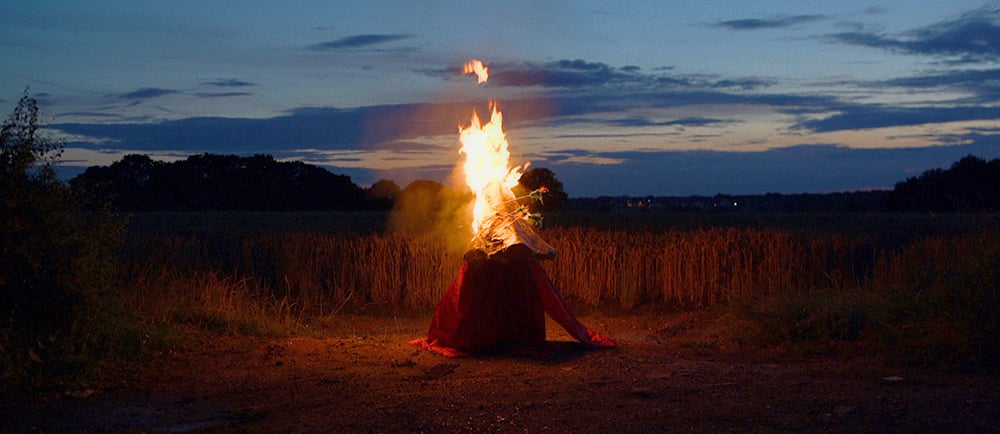Inspired by the fantastical worlds of Alice In Wonderland and The Wizard of Oz, Muntjac is an award-winning experimental short film about self-discovery that is set for public release this autumn. With an original score, sound design, Foley and ADR by dBs sound duo Jamie Bird and George Ramsden, we caught up with the team behind the film to learn more about the making of the project.
Muntjac, the winner of June 2023’s Athens International Monthly Art Film Festival for Most Creative Storytelling, is an experimental short film written and directed by Finn Darrell and shot by Miles Ahmad. The film, which is, stunningly, Finn’s directorial debut, follows Sinus, a “small elf-like creature”, who is on a quest to find his lost twin Möbius and on his journey encounters characters that throw him off course, teach him something about himself and reveal the surreal nature of the world that surrounds him.
“It's a very abstract story,” says Finn, “There's a lot of symbolic meaning in it, a lot of personal, emotional meaning I injected into it. But in terms of the actual plot, it's the story of Sinus on a quest to find his lost twin Möbius… Möbius is the lost twin but that's symbolic. Sinus is Möbius and Möbius is Sinus, they're two sides of the same coin. Möbius is the shadow side and therefore, part of Sinus’ journey is to uncover this darkness and deal with it.”
Muntjac (Official Trailer) from Finn Darrell on Vimeo.
Finn, a non-binary multimedia artist also working in fashion, drag performance, poetry and photography, has written a film with reference and deference to the LGBTQ+ community and the personal journey many people within that community take, but the kaleidoscopic abstraction of the film warps the message, if there is one, in a way that ensures it remains covert and that the visual and auditory experience takes centre stage.
“Our intent was never to make a film that did well at festivals or hit topical, contemporary issues and subjects that people are dealing with,” says Miles, “We didn’t want to specifically say, ‘This is the meaning of the film. This is what we're setting out to do’... We wanted to make something that transcended away from that. Something that is more of a moment in time that we've managed to capture… There's a potent feeling of improvisation throughout it. I love the ambiguity of it. I think it kind of lends itself to being more experimental because it's not confined to any particular clear idea.”
Shot way back in the summer of 2021 across a “manic” five-day period, Muntjac is finally seeing the light of day. Recently screened at the Fringe! Queer Film & Arts Fest in Bethnal Green and Bristol’s Encounters Film Festival, the film will also be screened at Occulture, an esoteric conference in Berlin in October, and will be released unfettered to the public on Vimeo this autumn.
This long-protracted journey from inception to release has its roots in the student house parties of Bristol’s Screenology students. “Miles and all of our mutual friends were all at film school. I would go to these house parties over in Bristol with all these film students,” says Finn, “And then you came out of the blue with a film idea and some finance,” says Miles, “And said, ‘can you help me make this?’ and I was like, 'Yeah, sure!’”
With absolutely no directorial experience - “I didn’t know what a wide angle was! I didn’t know anything” - Finn relied on Miles’ tutelage to bring their idea for Muntjac to life.

“I started writing Muntjac in May 2021,” says Finn, “As soon as I had something ready, we got straight into pre-production. We knew that we wanted to film in the summer, I knew that I wanted Miles to be the DOP and that was all I knew. I had never studied film at that point so I didn't know what I was doing. I was relying on Miles to send me all of his past pre-production spreadsheets so I could get a feel for what the hell you're supposed to do when you make a film! We spent about three months doing that pre-production, we were hyper-productive and manic, and then we shot it in five days.”
The five days of shooting resulted in rich, visually stunning footage led by Miles - a Screenology graduate whose credits include directorial roles on short films and assistant director roles on Marvel blockbusters - who tried to strike a balance between calculated, improvised, ordered and disordered sequences throughout the film. “I've always been a fan of symmetry and Kubrick's work,” says Miles, “Making things ordered or disordered depending on where you are in the story. During the years before shooting the film, I'd been experimenting with handheld work and trying to knit sequences together through improvising movements with actors.
“We had some really calculated sequences in the film. For example, when the characters are walking with a piece of string, that all had to be measured to the tee in order to have the characters in the right place and the tripod at the right height and the right lens and the right aperture and focal distance and all of that. Then we have these sequences, for example, after Sinus jumps out of the bath and they're all running around, that was just a pure improvisation with Finn and I running behind the camera and trying to create some feeling of life… Finn allowed me the time and space for improvisation, which was amazing. You don't know if it’s going to work yet, but you want to just allow space for some kind of magic to happen. That was the ethos behind the photography; measured improvisation.”
In the white heat of pre-production, driven by both budgetary and creative motives, Finn and Miles decided that they would not record any audio during the filming process and that they would rely on all audio to be created in what would turn out to be a long post-production phase. “We wanted to tackle this film in a different way. It's similar to how Mark Jenkin made Bait, for example. Recording it all and then going back and finding the sound once you have finished the edit and know what the pace of it's going to be,” says Miles, “We wanted to be able to create a film that felt expansive in the five days that we had to shoot it and we tried to eliminate as many elements of the production that would slow us down.”
The decision not to record any sound during the filming of Muntjac meant that Finn and Miles would need to work with audio professionals they could trust to get the job done. This led them to Jamie Bird and George Ramsden - two dBs Institute BA (Hons) Music & Sound for Film & TV graduates that Miles had worked with previously - who would go on to create the complex and mesmerising auditory world of the film during the long period of post-production.
“The film doesn't really have any dialogue, so I knew that the score from Jamie was going to be as important as the photography. The score and the ADR had to match the visual side of it - the film is auditory as much as it’s visual,” says Finn, “Luckily, I'd worked with George and Jamie before on a short film where I didn't record any sound at all either,” continues Miles, “So I had confidence in their amazing ability to basically build something from scratch. Not only build the Foley but create layers of Foley amidst atmosphere, amidst the score and have all of those elements working in tandem and kind of symbiosis together.”

Enlisting Jamie and George, Finn and Miles began editing the footage they had captured to get a sense of the pace of the film, what they wanted the auditory world of Muntjac to sound like and then began writing the ever-changing reams of briefing notes that would drive the score and sound design.
“Each scene has its own sound palette,” says Finn, “That's how Miles and I were discussing it when we were sat in the editing room. During that process, we always had music on to keep us from going absolutely insane. I think that sparked a lot of ideas and we got very overexcited with all of the ways in which a sound can change the atmosphere of a scene.”
“We'd switch from Bach to Thom Yorke and Trent Reznor one day and then we'd be on Caravan Palace and strange folk music the next day,” says Miles, “That music was already influencing the rhythm and pace of the film. It was around us constantly.
“We edited half at Finn's house and half in this Russian Orthodox cottage with no TV and nothing to entertain ourselves but books and a piano,” continues Miles, “It was a very austere environment, so we came out with this very particular energy coming into the brief for George and Jamie. We were quite clear on the influences and the different artists that we liked but there was also the consideration of how the sound palettes were going to shift throughout. George and Jamie were so quick to start throwing ideas down of where things could go amidst all these other tracks we were trying to get the licencing for. They were just amazing at helping to evolve and work in an organic way with us. What was lovely about working with both of them was that we tried to keep egos out of everything. If an idea wasn’t gelling, they'd say, ‘Oh, yeah, of course. If it's not working, it's not best for the film,’ and then they'd completely scrap the thing they were doing and come back with something even better the week after.”
The resulting audio ecosystem of the film is a sea of shifting sands that moves seamlessly through genre and emotion - at times buoyant and at others frenzied - with sound design, ADR and Foley work that perfectly matches the surrealist bent of the film’s visuals and narrative arc. With little dialogue, the sound experience of the film takes centre stage but the movement of the audio remains subtle - you can feel the shifting of atmosphere without noticing how each new phase starts or ends.
“They say great art is when you can't see the process, you can only see the end result,” says Miles, “And even throughout the process of making the film, Jamie and George were delivering that constantly. Both of them are so inventive when it comes to how we think about sound or how we communicate ideas of fear or happiness. They were able to bring so many different styles and innovate throughout each different sequence.
“Jamie's score is just this roller coaster of emotions, starting with this kind of Sergio Leone/Mica Levi western and then pushing it to these strange horror film spaces, distorting things and then making it beautiful again. Jamie incorporated some of Finn’s old recordings of their older brother’s choir that they were in when they were a child and used all of these different sources and united them all… I don't know how George does it. George can somehow create the Foley for anything you see on screen in his back garden and make it all sound like it was recorded there on the day. It's pretty amazing seeing the reality that he breathes into things. He makes punches feel real. He makes people's footsteps when they're running away scared feel real.”
“I was just so flattered that they were happy to invest so much in the project,” continues Finn, “It was a big project to do and I was really impressed every step of the way. Even the first draft they sent us I was like, ‘Wow, this is going to be great.’”

The joy of working on Muntjac was reciprocated by both Jamie and George. “The director Finn is fantastic,” says Jamie, “They’re truly innovative and have a really conceptualised vision,” but the creative decision to omit dialogue throughout the film and not record any audio during the shoot did pose challenges for them both.
“I somehow manage to have this knack of working on films with no dialogue at all. So quite a lot of the narrative drive is through the music and it was exceptionally challenging,” says Jamie, “It was a big, very collaborative effort between myself and Jamie. A lot of back and forth and sharing ideas,” continues George, “It was a huge undertaking and a joy to work on. It really allowed me to stretch my skill set and experiment with the more surreal aspects of the film, which was a lot of fun. It’s been a big learning experience and I'm over the moon. I’m very proud of it.”
In terms of the music, the brief given to Jamie differed wildly from anything he had ever worked on before, switching genre and mood from sequence to sequence and forcing him to learn new instruments and styles of music. “Fundamentally, my thing is usually big synth-based Vangelis-style stuff, but this score is so diverse,” says Jamie, “Finn would be like 'For this section, I want traditional folk music,' so I managed to get an accordion from the 1920s, learnt how to play it, learnt how to play a bit of viola and put in some janky folk-style stuff and eventually, it got passed. It's challenged me so much… You always want to be feeling you're producing better work than your last project and I feel like this is the next step. It's not a traditional ‘me’ type of score even though there are elements of that. It's much more developed and considered.”
From a sound design perspective, Muntjac allowed George the opportunity to work on a project where he has, “Done the most roles and worn the most hats. I did the sound design, sound editing, Foley dialogue editing and ADR.” The sound design work took him to France, where he recorded carpenter bees for a sound which became a motif throughout the audio palettes of the film. “I'd never seen them before,” says George, “but my first instinct was obviously to grab my recorder and record them. So I got loads of stuff early on before I even got any version of the film because I knew what Finn and Miles were looking for from talking to them.”
Jamie and George are both recent graduates of dBs Institute’s BA (Hons) Music & Sound for Film & TV degree course at our Bristol campus, meeting each other during their studies and forging a complementary and cross-discipline working relationship.
“We're kind of chalk and cheese when it comes to projects,” says Jamie, “We work exclusively with each other and it's a good dynamic that was forged at dBs. George's sound design elevates my score and vice versa. It's a fusion of disciplines.”
“We are partners in sonic crimes, so to speak,” continues George, “We complement each other very well in terms of our workflow and interests in the aspect of sound. There's no ego. For example, there's no like, ‘I want the sound design to take over here and the music can take a backseat,’ it's not about that. It's about whatever serves the film and the narrative. Jamie gets that and I get that. So that just makes working together an utter delight.”
Jamie and George’s symbiotic working relationship was established at dBs and nurtured by the structure of the BA (Hons) Music & Sound for Film & TV degree course and how it cultivates collaboration across disciplines, with some students honing in on composition and others honing on the sound aspects of the course. By creating those connections during study and working on briefs that reflect the high-pressure nature of the industry, the degree prepares its students for the professional world.
“The project-based, fast turnaround nature of the module absolutely sets you up for reality in the industry. You don't have time to rest on your laurels and I think dBs is great for that,” says Jamie, “Without a doubt, 100%, unequivocally, I'm using everything I've learnt and implementing the techniques and processes into my projects with industry professionals now. I appreciated the fact that there's real encouragement for students to go and source collaborative projects with directors and filmmakers. dBs gives you a platform to go and find these opportunities, but fundamentally, it's down to you.”
“I’ve loved dBs,” says George, “I'm so glad I went on the course. I learnt a lot and came out better for it. It's got me to where I am today working on great films like Muntjac.”

With Muntjac now set for public release after a process that has stretched over two years, Finn says “it's a relief” to see the film “finally fulfil its purpose and be devoured by many eyes. I'm proud Muntjac has been accepted to award qualifying festivals, and I'm in butterflies of anticipation to watch it on the big screen again!
“I've been blessed to have Miles; a really talented Director of Photography. I think the fact that Miles and I had a relationship, and then Miles had a relationship with George and Jamie, so then I developed a relationship with them, really steered this project.”
For Miles, a graduate of one of our sister higher education institutes in Bristol Screenology, it’s been a “privilege to work alongside people from dBs over the past five years.” Working with “Jamie and George most notably, but other talented creatives too, it's been amazing to meet individuals who are as equally passionate about sound as I am about making films. To be able to go to an institute and become a post-sound mixer, a sound designer or a composer in your own right, and to be able to learn the skills to do that without having to go and apprentice someone, I think that's amazing.”
Muntjac will be released publicly on Vimeo in the Autumn for all to see!
If you want to follow in the footsteps of Jamie and George, check out our BA (Hons) Music & Sound for Film & TV degree today.


